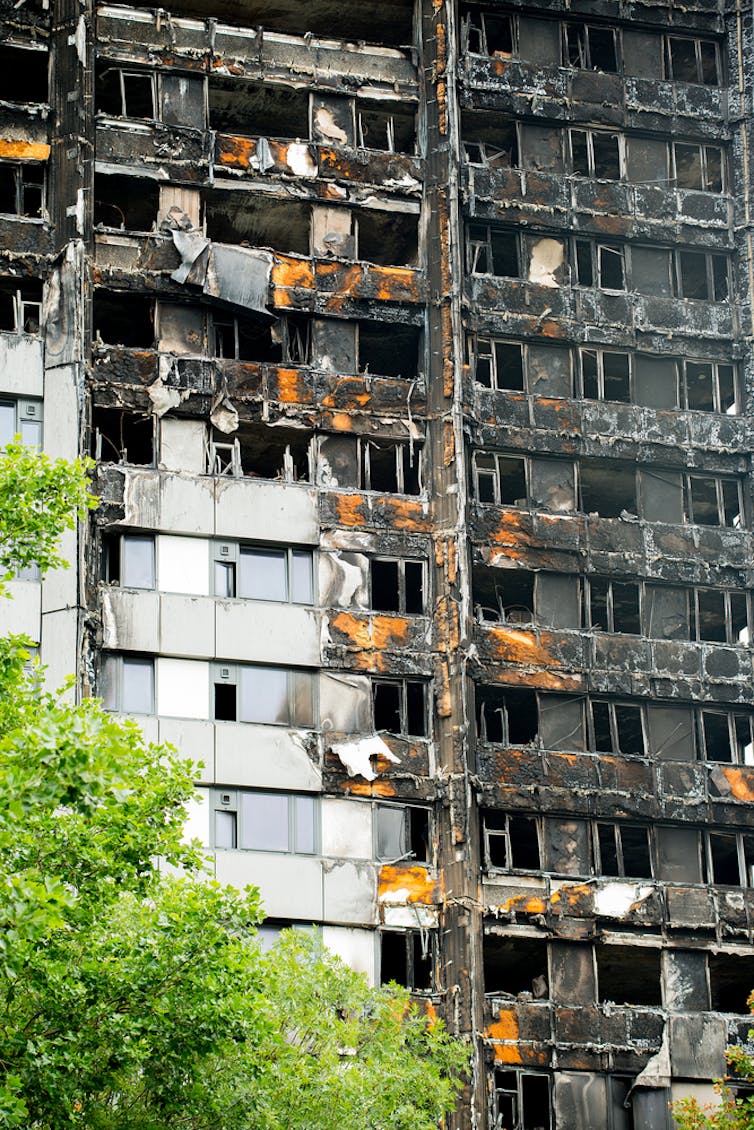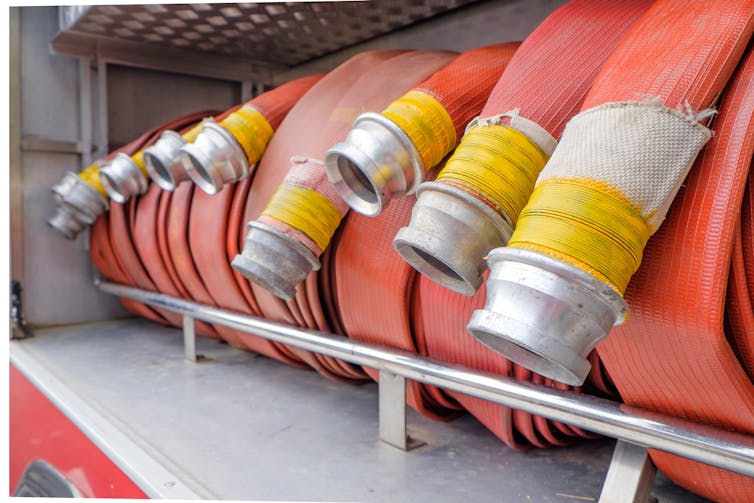Five years after 72 people lost their lives in the Grenfell Tower fire, which broke out on June 14, 2017, the UK government has announced plans to ban the type of cladding used to cover the external walls of the North Kensington high-rise. These revised building regulations are to be put into effect in December 2022.
The inquiry into the disaster concluded, in its first report in 2019, that this cladding – polyethylene-filled aluminium composite panels, to be specific – was responsible for the fire spreading so quickly.
Polyethylene-filled aluminium composite panels are lightweight, stiff and cheap. They’re coated with durable paint and can easily be formed into architecturally interesting shapes.
Of all the common plastics, polyethylene is one of the most easily ignited and gives off the most heat when burning. Because it has the same chemical composition as petrol, when it is molten, it burns ferociously with a high heat release.

John Gomez | Shutterstock
A multilayered fire hazard
Polyethylene-filled aluminium composite panels are typically a 4mm thick composite of two sheets of 0.5mm aluminium sheets sandwiching a 3mm layer of polyethylene. If heated by a fire, the polyethylene melts and pours out, where it can easily catch alight, thereby spreading the fire downwards through flaming, molten droplets.
The panels themselves aren’t the only problem, however. “Rainscreen” cladding systems, which are attached to the outside walls of large modern buildings to improve appearance and thermal insulation, are comprised of these outer cladding panels combined with an inner ventilation cavity (50mm wide) and a layer of insulation (100mm to 200mm thick).
This means that from the outside going in, after the cladding panel, there is a ventilated cavity and insulation, which is often combustible (usually phenolic foam or polyisocyanurate foam in the UK). This provides the fire with additional fuel, which burns more slowly. As a result, the contents of individual flats can catch fire. Catastrophic loss of life can follow, as occurred in the Grenfell Tower fire.
Critically, the air-gap, which is used to prevent moisture build-up, acts as a chimney. It allows flames to grow upwards inside it, inaccessible to firefighters’ hoses.
Conversely, in incidents where polyethylene-filled aluminium panels have ignited on buildings without insulation, such as the 2016 fire at the Address Downtown Hotel in Dubai, or the 2014 fire at the Lacrosse Building in Melbourne, flames have ripped up the outside of the building in minutes, but lives have not been lost.

Azami Adiputera | Shuttertstock
Inadequate regulation
Other cladding panel types include high-pressure laminate (similar to the material used to make kitchen worktops), which also burns with disastrous consequences. This is what happened in the 2009 Lakanal House fire in London and the fire at The Cube in Bolton in 2019.
There are estimated to be three times as many buildings clad with this laminate. The combination of both types of cladding panel (polyethylene-filled aluminium composite and high-pressure laminate) has led to thousands of occupants being unable to sell their homes.
Since the Great Fire of London in 1666, the use of combustible walls and roofs have been banned in England. The 2010 building regulations stated that “the external walls of the building shall adequately resist the spread of fire over the walls and from one building to another, having regard to the height, use and position of the building”.
But guidance as to how this regulation may be met was given in the 2006 edition of the UK government’s 180-page Fire Safety: Approved Document B. It explains that this can be achieved by the use of non-combustible products on the outside walls of the building, but it also allowed combustible products to be used, provided they met certain criteria (published separately in a document known as BR135) when exposed to fire in a large-scale test (following the BS 8414 test standard).
Our research has shown the inadequacy of this approach, because the ideal test environment differs significantly from the actual building. This guidance essentially made the use of combustible products on the outside walls of tall buildings possible. It required that these products either meet the BR135 criteria, or, in the absence of a test result, that a fire consultant undertake what is known as a “desktop study” to determine whether they would be likely to meet the criteria.
Climate change was used by the insulation industry to persuade regulators to increase the insulation requirements of modern buildings to conserve heat. This was done without considering the fire safety consequences.
The climate emergency is undeniably the biggest threat to humans and our planet. Domestic space and water heating accounts for around 20% of carbon emissions, and insulation reduces those emissions. But there are many ways to reduce carbon emissions, starting with leaving fossil fuels in the ground.
Some insulation products, such as glass wool and stone wool are non-combustible, and can safely be put on the external face of a building. Other insulation products (such as those phenolic or PIR foams, themselves derived from fossil fuels) have been shown to be safe in a fire only when enclosed in solid masonry. This however is more expensive, and may not be feasible when refurbishing an existing building.
The Grenfell inquiry has revealed gaping holes in the procedures for ensuring building fire safety, from product manufacturers, test laboratories, third-party certifiers, builders, architects and even regulators.
From a regulatory point of view, allowing combustible products to be used on external walls in the first place has been shown to be counterproductive. In many cases, they have actually been removed but not replaced. This has improved fire safety, but deprived the occupants of the insulation they had previously benefited from.
Further, the carbon emissions associated with remediation of buildings following the Grenfell Tower fire, to ensure fire safety, are likely to be greater than the potential savings from the improved insulation. Consequently, if non-combustible insulation and non-combustible cladding panels had been specified by the building regulations, not only could the Grenfell tragedy have been avoided, but the adverse climate effects of all the other unsafely clad buildings could have ultimately been lessened.
![]()
Richard Hull does not work for, consult, own shares in or receive funding from any company or organisation that would benefit from this article, and has disclosed no relevant affiliations beyond their academic appointment.











